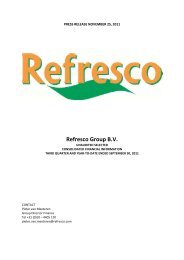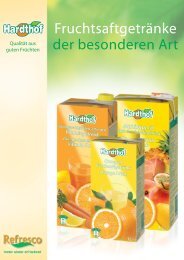Create successful ePaper yourself
Turn your PDF publications into a flip-book with our unique Google optimized e-Paper software.
Market review 2009<br />
Trends in the soft drink & juice market<br />
The past year, 2009, was dominated by the recession that started in the second half of 2008 and shook the entire<br />
world. Many segments felt the impact, with consumer behavior drastically turning around. The soft drink and juice<br />
business in which <strong>Refresco</strong> operates was, in its own way, also touched by the economic downturn; however, the impact<br />
was strongly <strong>de</strong>pen<strong>de</strong>nt on segment and category.<br />
In this section we give an overview of the major market trends<br />
in the European soft drink and juice business in the past year.<br />
Information is gained from market intelligence agencies and<br />
from our own experiences.<br />
Market movements<br />
Over the last three years, the growth of the European soft drink<br />
market has been slowing down to a negative 0.4% growth rate<br />
at 145.5 billion liters. For the larger Western European countries<br />
market conditions for growth have been mo<strong>de</strong>st, with large<br />
variations between categories.<br />
Overall, in 2009 the soft drink market in Europe <strong>de</strong>clined<br />
by 2.34 million liters (-1.6%) compared to 2008. European<br />
consumers have reduced their spending fuelled by<br />
unemployment fears and uncertainty over the economic<br />
recovery. Reduced spending has mainly affected on-premise<br />
consumption. In some European markets, off-premise has<br />
compensated for falling on-premise consumption, mainly<br />
as a result of massive price promotions and the excellent<br />
performance of some private label products.<br />
In 2009 packaged water still has the highest market share<br />
(41%) by volume, but suffered a loss of 905 million liters,<br />
mainly as a result of unfavorable weather in parts of Europe,<br />
low on-premise consumption, and consumers switching to<br />
more economical alternatives, such as tap water, as a result<br />
of the economy. Carbonated Soft Drinks (CSDs) <strong>de</strong>clined by<br />
915 million litres in 2009, mainly as a result of heavy losses<br />
in Eastern Europe, with the exception of Poland. In Western<br />
Europe, CSDs registered slight growth, mainly as a result of<br />
the positive performance of private labels in countries such<br />
as Germany. The ‘un-healthy’ image of CSDs is also affecting<br />
growth in some markets but CSDs still maintain the second<br />
largest market share of European consumption at 32.4% for<br />
2009. Juice suffered a loss of 607 million litres, mainly due<br />
to consumers switching to more economical fruit beverages<br />
such as nectars and fruit-flavored still drinks as a result of<br />
the economy. Conversely, the strong move towards smoothies<br />
and Not From Concentrate (NFC) juices continued, filling the<br />
<strong>de</strong>mand for healthier products. Squash/syrups was one of the<br />
few categories to register a positive performance in 2009 as<br />
a result of its cost advantage in times of economic hardship.<br />
Ready to Drink Ice teas/coffee drinks and energy drinks had a<br />
positive performance across Europe, albeit from a low base.<br />
The steady volume growth of energy drinks still perseveres<br />
(9.4%), but these still have a very small market share (1%).







